Bow Loop Dredging |
|
Design and Construction Award
Project Team
Client: Canal
& River Trust (nee: British Waterways)
Designer: Canal
& River Trust (nee: British Waterways)
Construction: Land
& Water Services
Background
The Bow Back Rivers are a 5.5 km system of waterways in East
London that feed into the River Lee Navigation and the River Thames.
They cover an area of 214 hectares, equivalent in size to the city of
London and have a long and rich history of industry and commerce. Historically
the waterways have also played a vital role in flood water management;
however the area had since fallen into decline, becoming unnavigable
and subject to antisocial behaviour and abuse.
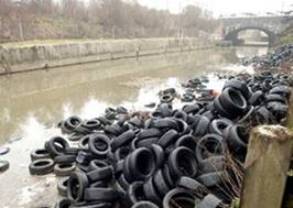
Flytipping on the network
Given that the Bow Back Rivers dissect the Olympic Park, they were uniquely positioned to play a central role in the delivery of the regeneration of the area for the Games and the long term legacy plans. The Bow Loop and associated waterways would contribute to the green and accessible environment that was the focus of the 2012 Games.

Flytipping on the network
The project
The Olympic Park waterways had been partially dredged a number
of years ago to create a freight route from the River Thames to the
Olympic Park. This project would see the full regeneration of the remaining
waterways running throughout the park and in particular the loop around
the Stadium, prior to the Games. The aim of the project was therefore
to create an attractive waterway environment that was also fully functional
in the short term and in legacy for future users.
The key design criteria were:
- To create a navigable depth throughout the park permitting access to, boat traffic for security staff, water taxi services for the summer Games and leisure craft for the legacy. This meant removing large volumes of silt and fly tipped debris.
- To undertake a programme of vegetation works, removing unsafe trees, controlling invasive plant distribution and planting an improved variety of wetland species.
- To redefine the line of waterway banks around the Stadium, to create an attractive green corridor that provides erosion protection, litter exclusion and ecological enhancement.
CEEQUAL was seen as the most suitable tool to assess the environmental performance of the project given its integration with the Olympic park and the underlying aim to deliver the most sustainable Games on record. We also took this opportunity to assess the performance of our National Contract and own Environmental Appraisal system and Environmental Management System. We were pleased to discover the close synergy between the two approaches and have been reassured that we are excelling in sustainable construction and environmental protection.
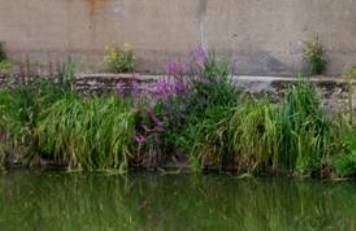
Gabion Planters on lengths of hard bank
Ecology (100%)
The installation of soft bank margins where possible, and the
installation of gabion planters in lengths of hard bank, helped the
project to score highly in the assessment in terms of ecology, through
the retention and extension of specific BAP ecological habitats (e.g.
rivers and reed bed). In addition specific species were targeted, such
as Sand Martins and Kingfishers, through the installation of nesting
sites and resting posts. Furthermore, dead wood was retained for bat
roosts and brash mattresses were installed to encourage fish spawning.
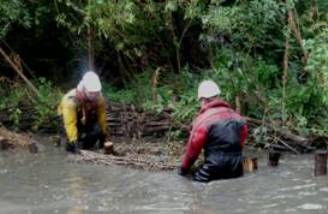
Installation of Coir Roll on areas of soft bank
A key outcome of the project was the ability to control the invasive plants colonising the waterway on the bank and the waterscape. Japanese Knotweed, Giant Hogweed, Duckweed and Floating Pennywort were all established requiring time and patience to control them.

Canal gravel dredgings arriving on site
Waste (94%)
Amongst the most challenging aspects was working out how to
sustainably manage over 37,570 tonnes of waste that would be generated
through the project. The majority of the volume would come from removing
the silt, gravel and debris that had built up over 50 years, so a dredging
profile was designed that maximised navigation and reduce the amount
of waste created. As much construction waste as possible was reused
on site for backfill of the new lengths of soft bank and a variety of
uses were sought for the remaining material, including landfill capping
and soil washing to reclaim the material as aggregate. In addition the
flytipped material (such as metal, timber, cars and electrical appliances)
were removed and recycled directly. In total we managed to reuse 83%
of waste arisings, recycle 15% and only dispose of 2% of the total waste
generated.
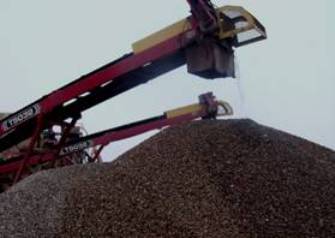
After being washed
Both client and contractor were exceedingly happy with the quality of the projects’ outcomes and successful establishment of the new greener corridor. Many visitors throughout the Games complimented the waterways and Canal & River Trust are happy that it is a fitting legacy from highly succesful Olympic and Paralympic Games.

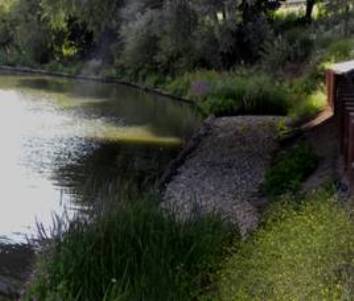
Example of waterway bank before and after the works

